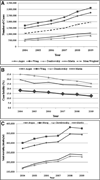The Changing Epidemiology and Definitions of Sepsis
- PMID: 27229635
- PMCID: PMC4884306
- DOI: 10.1016/j.ccm.2016.01.002
The Changing Epidemiology and Definitions of Sepsis
Abstract
This article describes the trends in the incidence of and mortality from sepsis in the United States and globally. The article then discusses the known factors associated with increased risk for developing sepsis and the limitations of the current clinical definition and the clinical correlations of the current epidemiology.
Keywords: Epidemiology; Sepsis; Septic shock; Severe sepsis.
Copyright © 2016 Elsevier Inc. All rights reserved.
Figures





References
-
- Moss M. Epidemiology of sepsis: race sex, chronic alcohol abuse. Clinical infectious diseases : an official publication of the Infectious Diseases Society of America. 2005;41(Suppl 7):S490–S497. - PubMed
-
- Botero JSH, Pérez MCF. The History of Sepsis from Ancient Egypt to the XIX Century 2012. Available from: http://www.intechopen.com/books/export/citation/EndNote/sepsis-an-ongoin....
-
- Angus DC, Linde-Zwirble WT, Lidicker J, Clermont G, Carcillo J, Pinsky MR. Epidemiology of severe sepsis in the United States: analysis of incidence, outcome, and associated costs of care. Critical care medicine. 2001;29(7):1303–1310. - PubMed
-
- Dombrovskiy VY, Martin AA, Sunderram J, Paz HL. Facing the challenge: decreasing case fatality rates in severe sepsis despite increasing hospitalizations. Critical care medicine. 2005;33(11):2555–2562. - PubMed
-
- Martin GS, Mannino DM, Eaton S, Moss M. The epidemiology of sepsis in the United States from 1979 through 2000. The New England journal of medicine. 2003;348(16):1546–1554. - PubMed
Publication types
MeSH terms
Grants and funding
LinkOut - more resources
Full Text Sources
Other Literature Sources
Medical

